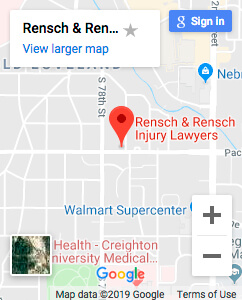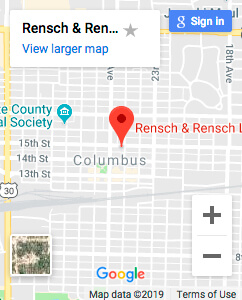Omaha Nebraska Motorcycle Accident Attorneys
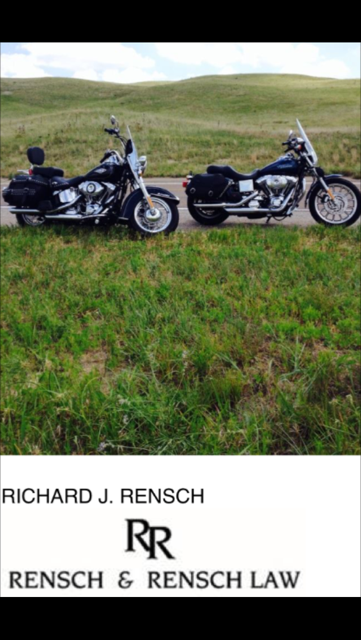
According to the National Highway Traffic Safety Administration, in 2013 alone 4,668 motorcyclists were killed in traffic accidents and another 88,000 were injured. Compared to passenger car occupants, motorcyclists were 26 times more likely to die in a traffic fatality. If you’ve been hurt in an accident, you may be facing a range of challenges. Riders are among the most vulnerable road users. When other drivers make mistakes, motorcyclists are often the ones who suffer the most serious and life-changing injuries. If you’ve been seriously injured, are struggling with medical and rehabilitation expenses, or have had to miss time at work due to your accident, you don’t need to suffer alone. Rensch & Rensch Law are top accident attorneys in Omaha, NE. We can help you.
Many motorcyclists are safe road users, following the law and taking precautions to avoid accidents. Unfortunately, even the most cautious motorcyclist cannot prevent an accident when another driver makes an error. In the pain, trauma, and confusion that immediately follows an accident, you may not always know what to do. If you’ve been hurt, first get proper medical attention immediately. Then, seek the assistance of an accident law firm in Omaha, NE. Rensch & Rensch Law are the best Omaha motorcycle accident lawyers in the state and understand the risks that motorcycle riders face. We know common road errors drivers make and will fight inside or outside of court to get you the justice and recovery you deserve.
Justice for Motorcycle Accident Victims in Omaha, NE
Human error accounts for the majority of all accidents. What are some common driver errors that lead to accidents? Here are a few:
- Changing lanes. Drivers aren’t always looking out for motorcycles when they are driving. Motorcycles are more likely to be in a driver’s blind spot. One of the common accidents that leads to injuries occurs when drivers change lanes without properly looking.
- Rear-end collisions. Rear-end collisions occur when a driver misjudges the speed of the driver in front. In some cases, drivers don’t realize that a light has changed. In other instances, alcohol or drugs are involved and affect a person’s reaction time. Unfortunately, when motorcyclists are rear-ended, the bike doesn’t offer the same buffer that trunks and bumpers in cars do. You are more likely to sustain more serious injuries as a result of this kind of crash.
- Opened car doors. If you’re driving in an area where cars are parked on the side of the road, your risk of being hit by an opened car door increases. Many bikers and motorcyclists die every year because a driver or passenger failed to look before getting out of his or her car.
- Speeding can lead to a deadly accident in every case, but when a motorcyclist encounters a speeding vehicle, the risk of serious and life-altering injuries increases.
- Driver distraction. Cell phone use, text messaging, and making phone calls account for more accidents every year. Drivers who aren’t paying attention to the road are more likely to hit motorcyclists.
- Improper turns. Drivers don’t always judge their distance and timing well when it comes to motorcycles. While drivers are accustomed to judging speeds of cars, they are not as practiced in judging speeds and distances with motorcycles.
Many of the same factors that lead to passenger car accidents affect motorcyclists. Unfortunately, when riders get hit, they face more serious injuries, longer recovery periods, and may even have to miss time from work. If you’ve been hurt in a motorcycle accident, contact the Omaha Nebraska motorcycle injury lawyers at Rensch & Rensch Law today. Other drivers may try to pass the blame onto you. We know how to study your case to make sure that you receive the money you deserve to recover and move forward with your life.
Find a Motorcycle Accident Lawyer in Omaha, NE
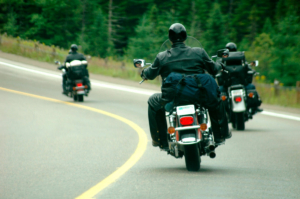
Attorney Richard J. Rensch on a road trip.
A qualified motorcycle injury attorney in Omaha will understand the unique challenges that riders face. Insurance companies sometimes try to downplay injuries and faults to avoid having to pay. You need an accident law firm that can work with insurance companies to make sure you get the recovery you deserve. You may only have a limited amount of time to seek money to cover your medical expenses, pain and suffering, lost wages, and recovery expenses. Rensch & Rensch Law are top motorcycle accident attorneys in Omaha who will take the time to review the details of your case, speak to witnesses, talk to insurers, and fight for the best possible outcome. Don’t suffer alone. Contact Rensch & Rensch Law today.
A Rider’s Rules of the Road:
City Streets and High-Speed Roadways
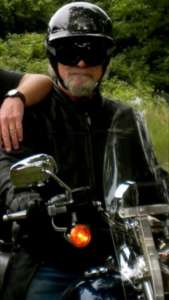
Attorney Richard J. Rensch
Senior partner of Rensch & Rensch Law, Richard Rensch, is an avid motorcyclist. Spring, summer, and fall, Dick rides his Harley Lowrider to work nearly every day – except when in court. His daily roundtrip combines over 15 miles of Omaha’s heaviest high-speed freeway traffic with the city’s mixed urban neighborhood commuter traffic. His younger brother, Jeff, recently bought a BMW 1200. They ride together from time to time and therefore Jeff, on occasion, is the object of brotherly advice intended to improve his well-being, riding experience, and life expectancy. The following highlight the most important insights Dick has learned about safe riding practices that you (as a novice or old pro) might want to consider:
- Lane position. Visibility and precaution are the key considerations. When driving on any road or city street with just two lanes of travel (one for each opposing direction) stay away from the center line. Give yourself time to move out of the way – to the right – for traffic crossing the center line. For similar streets in residential districts when passing by vehicles stopped at intersections obeying stop signs waiting to cross or turn onto your street, get close to the center (when no oncoming traffic is approaching) to make yourself more visible to those drivers at stop signs. When traveling on four-lane streets through town (two lanes for each opposing direction) – follow generally the same rules. Try to stay out of the outside or curb lane for visibility’s sake, and position yourself on the far right border of the inside lane of travel.
- 2-3 Second Rule Minimum. This is mandatory if you want to live out your life expectancy. It is not a 1 second rule. Feel free to extend it to 4 seconds. This means you must travel (at any speed) at least 2-3 seconds behind the moving vehicle in front of you. To determine the proper distance is simple. Watch the vehicle in front of you pass a landmark that you will be forced to pass as you follow. As the landmark is passed by the vehicle ahead, start counting 1001, 1002, 1003. Slow down until you can count two to three seconds off before reaching the same landmark. It is a scientific certainty that it takes the human brain ¾ of a second to perceive danger and another ¾ of a second to act upon such danger. That means before you can apply your brakes at 60 miles per hour, you will have traveled 132 feet (about ½ the length of a football field!) after a potentially fatal situation presents itself ahead of you. By keeping the 2-3 second rule you will give yourself a chance to recognize and effectively react to most emergency situations.
- Eyes forward. It is the object ahead of you that kills you. Focus your awareness ahead of you. Constantly sweep your forward danger horizon. Your danger horizon is the imaginary horizontal arch extending out ahead as far as you can reasonably discern approaching objects, traffic patterns, and road configurations that pose any potential for harm. You cannot allow anything to block your view of the danger horizon for more than a few seconds at a stretch. Strategically maintain a position within your lane that allows for your best view of your danger horizon. Continuous monitoring for and early detection of dangerous road debris such as truck tire shreds (called gators) or potholes, will save your life – over and over again. You want to stay ahead of the information available to you in order to diffuse any potential harm and prevent emergencies from happening altogether.
- Cover both your front and rear brakes in traffic. In city driving when going through intersections and in mid to heavy traffic, keep two fingers over the right front brake lever and the ball of your right foot touching the rear brake pad. That will cut down on the read and react time (discussed above), in case an emergency arises. Your front brake is more important to you for a quicker stop. 60-80% of the brake power shifts to the front (because of the combined forward weight shift of the rider and bike) in a slowdown. Practice braking on lonely stretches of roads or in empty parking lots. Always expect a dangerous emergency. Never rely on the driving abilities of anyone on the roadways – but yourself.
These pointers are intended to add to the arsenal of defensive riding strategies the reader has acquired to date. Following these and other time-tested biker rules of the road should dramatically enhance your riding pleasure and well-being along with those who share the highways with you.
Best Motorcycle Accident Attorneys in Omaha

Riding a motorcycle in Omaha can be a thrilling experience. Many motorcycle riders are trained, skilled, and safe, but they are also aware that they cannot control the actions of other drivers on the road. Drivers of trucks and passenger vehicles may not always be looking out for motorcyclists. Many motorcycle accidents occur when vehicles are turning. Drivers may be looking out for large trucks or other passenger vehicles, but may not see when a motorcyclist is too close. When accidents do occur, the clear majority of the time the collision is not the fault of the motorcyclist, the person most likely to suffer serious injuries is the rider. Motorcyclists don’t have the protective chassis of a car to prevent them from hitting the ground in an accident. This can lead to more serious injuries with longer recovery times. This can place immense stress on motorcycle accident victims and their families. Riders may miss time at work, face long recovery periods, experience pain and suffering, and incur expensive medical care bills. While the law offers protections to injured motorcyclists, riders and their families may not always know what steps they need to take to protect their rights after a crash. Rensch & Rensch are the best Omaha NE motorcycle accident attorneys who work tirelessly to protect the rights of survivors of motorcycle crashes. If you or a loved one has been hurt in a crash, contact Rensch and Rensch motorcycle accident attorneys today to learn more about your rights.
Insurance and Motorcycle Accidents in Omaha
Before Riding Your Motorcycle
Buy adequate insurance coverage for your own protection. Buy the highest amount of insurance coverage you can afford. Do not skimp. You will be surprised how cheap and rewarding it is – going to the next level of coverage. You want liability coverage that protects your gross assets and earning power in the event you make a critical mistake causing catastrophic injury to others. More importantly, you want to buy the highest amount of uninsured motor vehicle insurance and underinsured motor vehicle insurance coverage you can afford for those bad drivers out there who negligently drive around uninsured or who are underinsured because they purchased only the statutory minimum in liability coverage. In Nebraska, the minimum is $25,000. Assume that when you are involved in a motorcycle accident – you will suffer severe – catastrophic injuries, due to negligent automobile drivers. There is no getting around the fact that the likelihood is great a motorcyclist will break bones, suffer internal thoracic and/or head injuries, and lose weeks of work because of a contact collision between auto or truck and motorcycle.
Take it from the lawyers at Rensch and Rensch – if you follow our suggestions you will thank the day you read these words. We advocate purchasing a policy that provides much more than the State mandatory minimum. At the very least, riders should buy coverages of $100,000/$300,000 on liability, uninsured motorists, and underinsured motorists. Why protect others from you – more than you protect yourself from others? The whole idea of uninsured motorist insurance and underinsured motorist insurance is to protect yourself and your loved ones from dangerous drivers who don’t care about your well-being or the well-being of your loved ones. We also strongly recommend at least $10,000 in Medical Payment Coverage (Med Pay) that inexpensively protects you and your passengers. A medical payment endorsement doesn’t cost much and provides payment for medical bills only – regardless of fault. As explained below, Med Pay can be used by you in some cases to pay your Health Insurance co-pays.
After Your Motorcycle Accident
If you are injured in a motorcycle accident, there are some immediate steps you can take to further protect yourself and your legal rights. What steps should you take following a motorcycle accident in Omaha? Here are a few things to consider:
- Seek medical attention.
- Report the accident to the police.
- Contact your insurance company.
- Find a motorcycle accident attorney in Omaha.

Attorney Richard Rensch
The Importance of Medical Care: If you’ve been in a motorcycle crash in Omaha, it is incredibly important that you seek appropriate medical care. Not all injuries manifest immediately when an accident takes place. For instance, motorcycle accidents sometimes result in head injuries. However, the symptoms of mild traumatic brain injury and other potentially deadly or dangerous head injuries can take hours, or days before symptoms appear. Protect yourself and your well-being and always seek proper medical care after a crash—even if you feel fine. Other conditions that can take a while to appear include post-traumatic stress disorder. Post-traumatic stress disorder can result in sleep problems, depression, and loss of enjoyment of life. Motorcycle riders may find themselves no longer wanting to ride, or panicking when they get back on a motorcycle. Proper medical care can help individuals reclaim their lives. Always seek the care of a doctor after a crash.
Give the Hospitals and Doctors (Providers) your HEALTH INSURANCE CARD AND INFORMATION: If you are smart or fortunate enough to have health insurance (private such as Blue Cross Blue Shield or public such as Medicare or Medicaid) furnish your providers with your insurance card and information. Demand that the providers submit your bills for your motorcycle accident-related treatment to your Health Insurer. The Providers will resist you. They want to get paid 100% of the inflated charges for their services. Your Health Insurer will have “Provider Contracts” with your providers. This requires the providers to bill only per the contracted schedule of payments for each coded type of treatment. Most of the payment schedules pay less than half the super-inflated medical charges. For example, a $1000 medical bill is reduced to $500. Your 20% co-pay is like-wise reduced from $200 to $100. Also, any reduction in the medical bill due to the Health Insurer’s provider contract will equate to a dollar-for-dollar increase in your pocket at the time of settlement. Why? Because the providers must be paid. They want to be paid 100% of their inflated bill from your settlement proceeds. That will not happen – if you follow these simple steps and USE YOUR HEALTH INSURANCE!
For those of you with Medical Payment Coverage (Med Pay), as part of your motorcycle insurance, use Med Pay to pay your deductibles, if allowed under the terms of your Health Insurance Policy. If you have Health Insurance, only give Health Insurance information to the providers. Do not give the providers the name of your liability carrier or the name of the liability carrier of the negligent driver. The key is to give out your Health Insurance information only – if you wish to maximize your settlement recovery.
Reporting the Accident: When you report the accident to the police, provide the officer with the facts, but don’t accept blame for the accident. Negligence for a motorcycle accident is often complex to determine. You may not be aware of all the laws involved or you may not be aware of all the factors involved. For instance, you may not know that the other driver may have been drinking or under the influence of drugs. Never accept blame. Answer officers’ questions honestly and clearly, but protect your rights after a crash. Reporting even a minor motorcycle accident is important because injuries don’t always make themselves apparent right away. Reporting the accident will help you if you later need to file a claim with insurance.
Contact Your Insurance Agent: As discussed in more detail above, all registered motorcycles in Nebraska must have proper insurance. Nebraska motorists are required to hold a policy that covers at least $25,000 in bodily injury and $25,000 for property damage. Some policyholders have higher limits. It can be difficult to know what a policy does and doesn’t cover and what recovery you may be entitled to receive. If you feel what the adjuster is offering to you for a settlement recovery is lower than what you need or expect, a top motorcycle accident lawyer in Omaha may be able to help you. Rensch & Rensch are among the best motorcycle accident attorneys in Omaha. We can speak to adjusters, read over your policy, and fight to help you get the recovery you deserve under the law. In some cases, you may be able to sue the negligent driver to make up for gaps in coverage. Every case is unique. Learn more about your rights by contacting Rensch & Rensch today.
If you’ve been hurt in a motorcycle crash, it may be wise to find a motorcycle accident lawyer in Omaha. Rensch & Rensch are qualified motorcycle accident attorneys. As riders ourselves, we understand the unique challenges riders face when they are on the road.
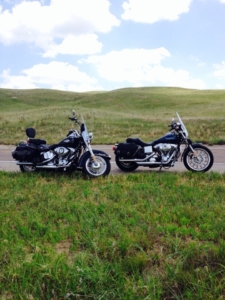
Attorney Richard J. Rensch on road trip.
Contact a Top Motorcycle Accident Attorney in Omaha Nebraska Today
There are many things to think about if you’ve been in a motorcycle accident. You and your loved ones may be struggling to figure out how to pay medical expenses or rehabilitation fees. You may be worried about the long recovery process. You may have to miss time at work and may wonder how you’ll manage financially with the loss of an income source. Fortunately, the law offers motorcyclists important legal protections following an accident. You may be entitled to collect a recovery to cover medical expenses, lost wages, pain and suffering, and property damage. You only have a limited amount of time under the law to file a claim. Rensch & Rensch are caring, compassionate, and aggressive motorcycle accident attorneys in Omaha Nebraska. We will speak to witnesses, talk to insurance adjusters, and investigate all aspects of your case to help you get the best possible recovery under the law. You don’t have to suffer alone. Our lawyers are motorcycle riders and we understand the challenges riders face after a crash. We can help.

